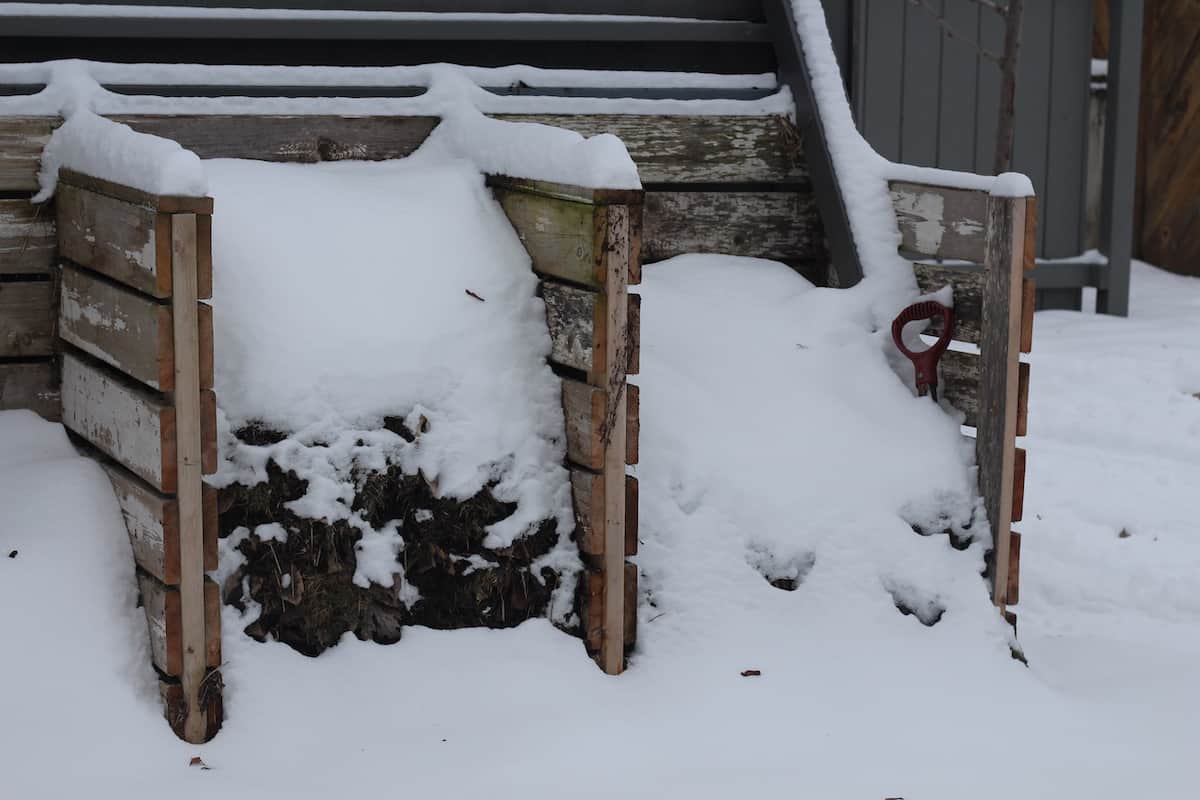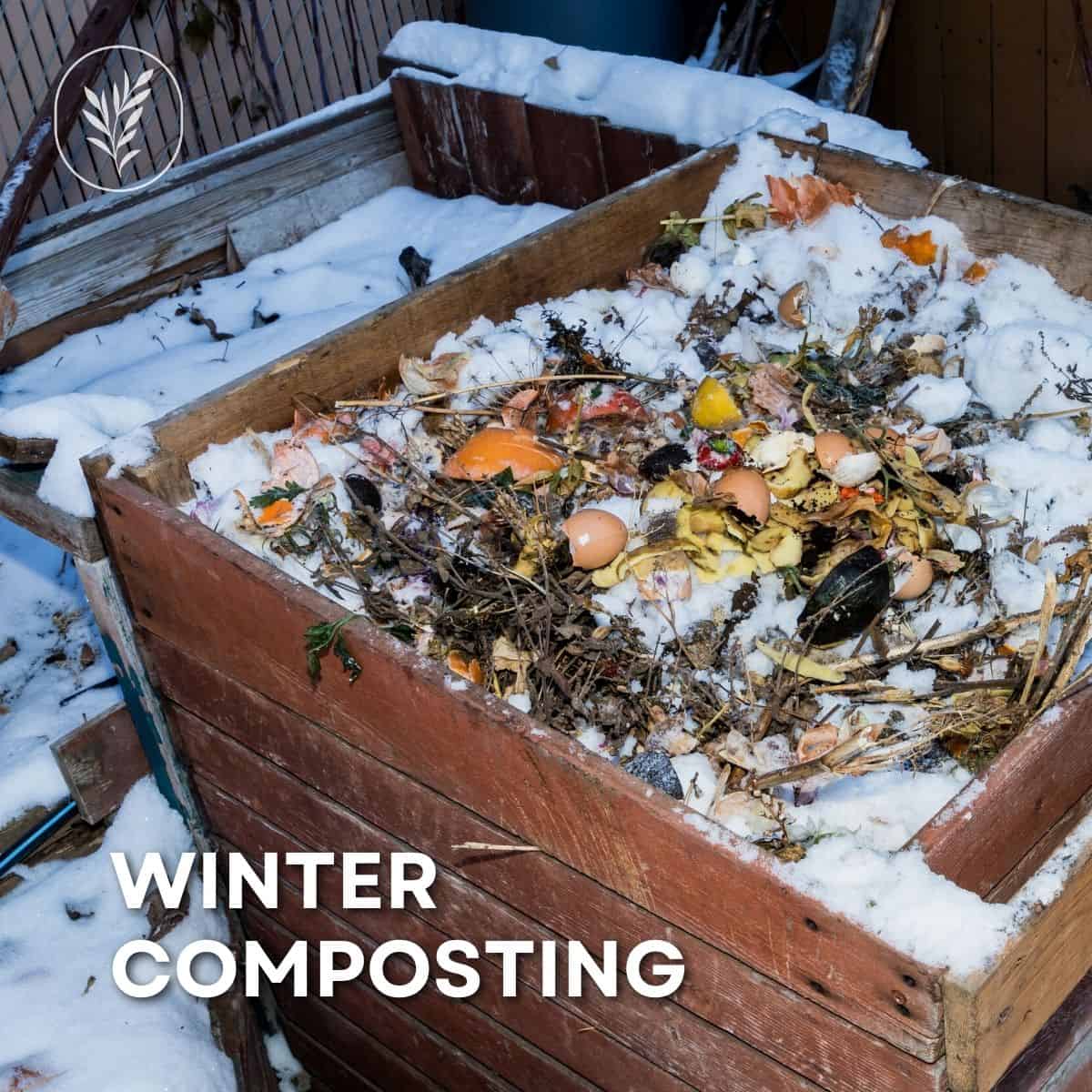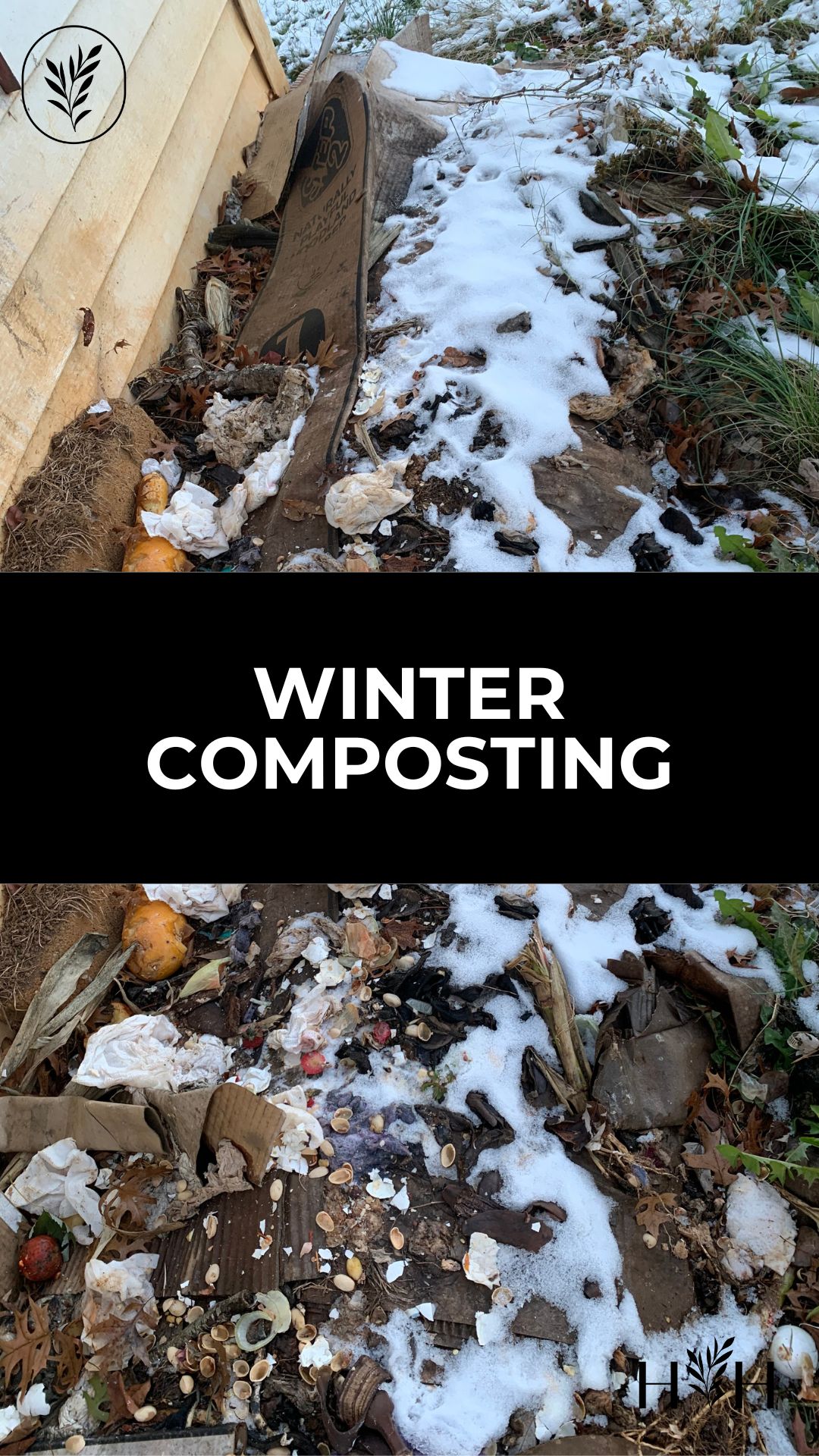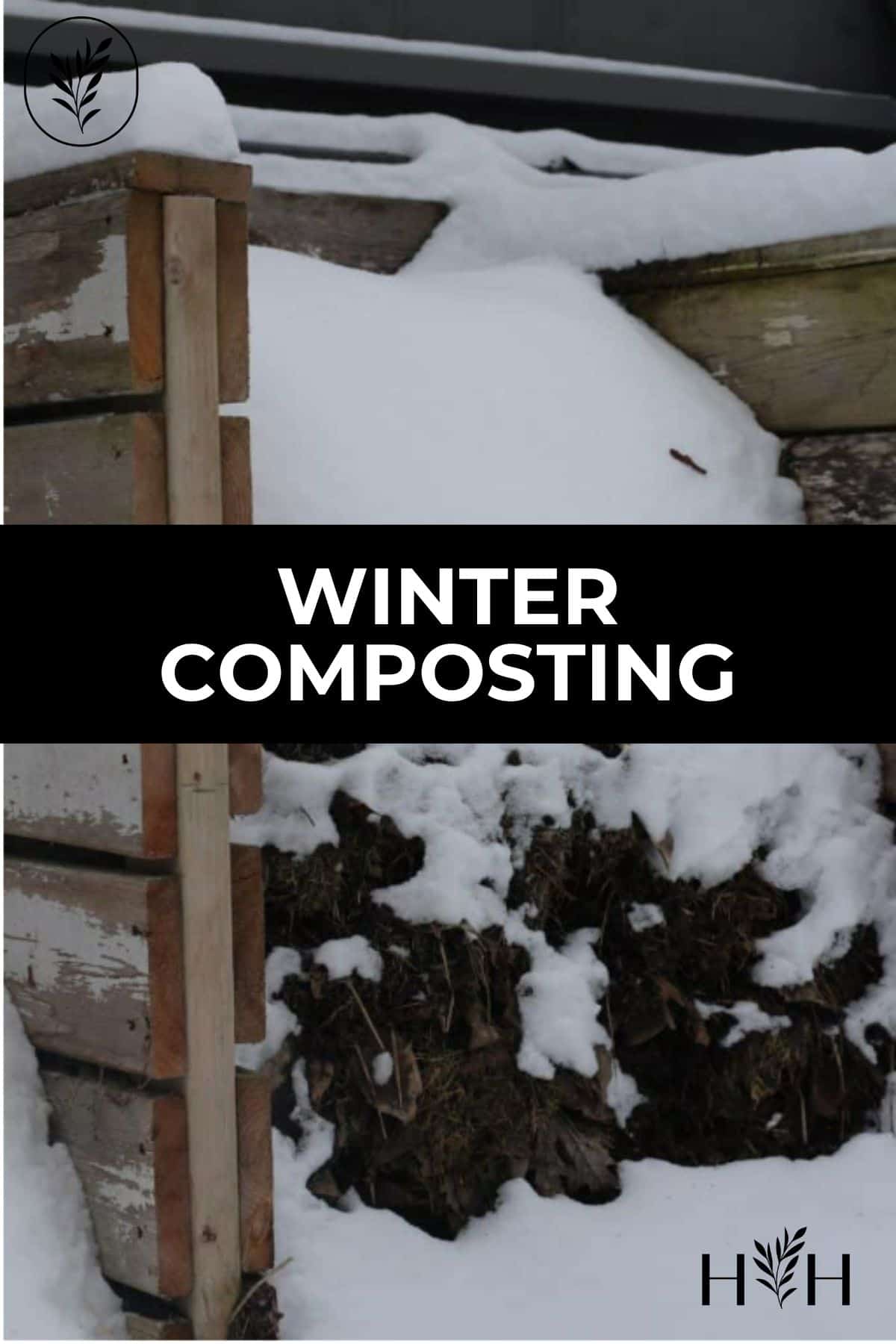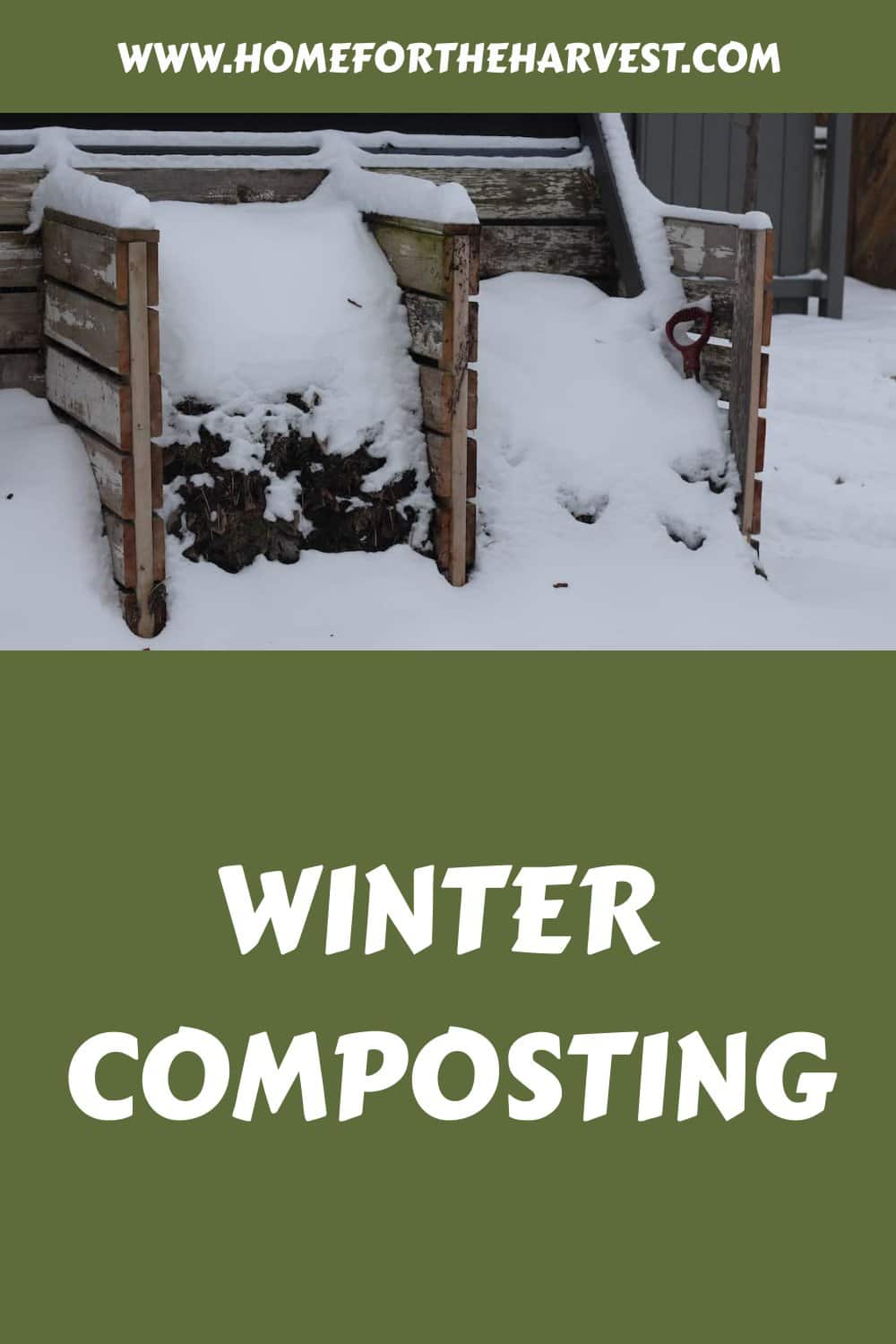Many of us stop composting our organic waste at home during the wintertime. The cold temperatures and decreased amounts of yard waste can make winter composting seem like it’s not worth the effort. Fortunately, there are a few tips to keep your compost pile happily decomposing during the colder months.
So, can you compost in the winter? Yes, you can certainly compost in the winter, even in places with freezing temperatures. The microbes in the compost will be less active in cold weather but will still do their job even if they do it at a slower pace. Alternatively, you can use an indoor composter like an electric composter. Whatever method you decide, you certainly can keep the compost going during the wintertime! You’ll reduce your organic waste and create a lovely, rich soil amendment for the spring garden.
Why is composting more difficult in the winter?
Composting is simply the activity of speeding up natural decomposition. The goal is to create a happy habitat for the microbes that decompose organic waste. This can be a bit tricky in the winter, but winter composting is certainly doable (albeit at a slower rate)!
“Compost piles that are actively managed will continue to decompose all winter long – just a bit more slowly.”
Winter Compost Piles Are Still Working, Michigan State University Extension, by Beth Clawson
Winter composting is complicated by two key issues:
- Outdoor temperatures are too cold for optimal microbial decomposition. Dry winter winds and cold drizzle don’t help.
- Households produce lots of nitrogen-rich food scraps but don’t produce enough carbon-rich “brown” material to balance it out.
Most of the organic waste produced during the winter months is kitchen food scraps. There may also be odds and ends in holiday decorations and crafts. But generally, there is less organic waste produced in the winter than in the other seasons. The browns available in the winter are generally shredded leaves collected in the fall or shredded paper from a home office.
Methods for winter composting
There are countless methods for winter composting. Outdoor winter compost methods generally include efforts to maintain a warm temperature and balance out green/brown material.
“Residents of your pile, like bacteria, molds, mites and actinomycetes can survive the cold. However, to prolong their active life over the winter, they will need warmth, food, air, and moisture.”
Winter Composting, Cornell University Cooperative Extension
Here are some of the most common outdoor winter composting methods:
- Compost tumbler (standard)
- Compost tumbler (high-efficiency)
- Compost bin
- Compost heap
- Compost trench (in-ground)
- Food waste pails with lids (for springtime composting in a heap or trench)
Winter is also a great time to start a small indoor compost for kitchen food scraps. Here are some of the best methods for indoor composting year-round.
- Countertop food digester
- Electric composter (see my review of the popular Lomi composter)
- Indoor vermicompost
- Indoor bokashi bin
New to composting? See this article for detailed info on how to compost using these methods.
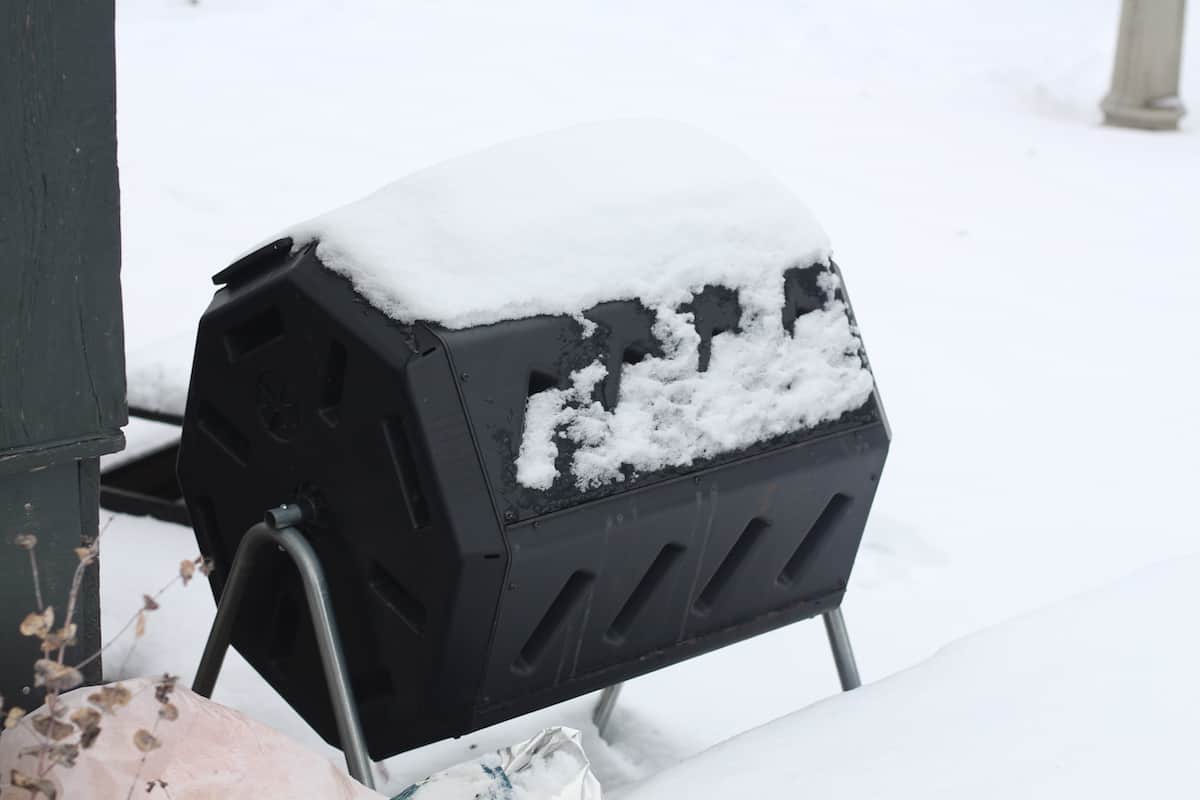
Choosing a winter composting method
Most households have mainly food waste scraps to compost in the wintertime. Fortunately, the average household only requires a small composter for a single household volume of food waste.
For fast composting, a compost tumbler can be a good choice. This is a metal or plastic container that is mounted on a frame so it can be easily rotated. A tumbler lets you easily mix and aerate the compost without much heavy lifting. Some of the newer tumblers are very efficient at retaining heat and creating a cozy environment for the beneficial microbes in the compost mix.
If you do have a large amount of waste to compost, a good old-fashioned compost heap is probably your best option. Consider whether you’re okay with walking out to the bin in the wintertime. Are pest animals an issue in your neighborhood during the winter? Will the path to the compost require shoveling when it snows? Consider these winter seasonal issues when planning out your winter composting location.
Snow and ice can create slipping hazards, so it may make sense to temporarily relocate the compost tumbler to a covered porch or other easily accessible areas. Place the compost where it will be safe and where you’ll most likely keep using it! Also, consider whether a small-scale indoor method of composting that can accept food scraps year-round makes more sense in your situation.
The basics of active winter composting
Compost microbes work slowly in colder weather. They still get the job done, though, and there are a few ways to help them out when ambient temperatures are low. Keeping the pile warm can keep the microbes actively decomposing the organics.
“Winter composting may simply involve tossing ingredients on the pile and waiting for temperatures to warm up in spring to complete the decomposition process. On the other hand, if you maintain a warm temperature in the interior of the pile, you can keep the decomposing microbes happy and somewhat active.”
Thoughts on Composting, University of Nevada Cooperative Extension
Here are some of the most effective ways to keep the compost active during the winter months:
- Site the compost in a warmer location
- Insulate the pile to help keep it warm
The key to successful winter composting is to keep the temperature of the compost warm even as outdoor temperatures drop. Keeping the compost warm is critical for the microbial decomposition on which success depends. Read on for tips on how best to do this.
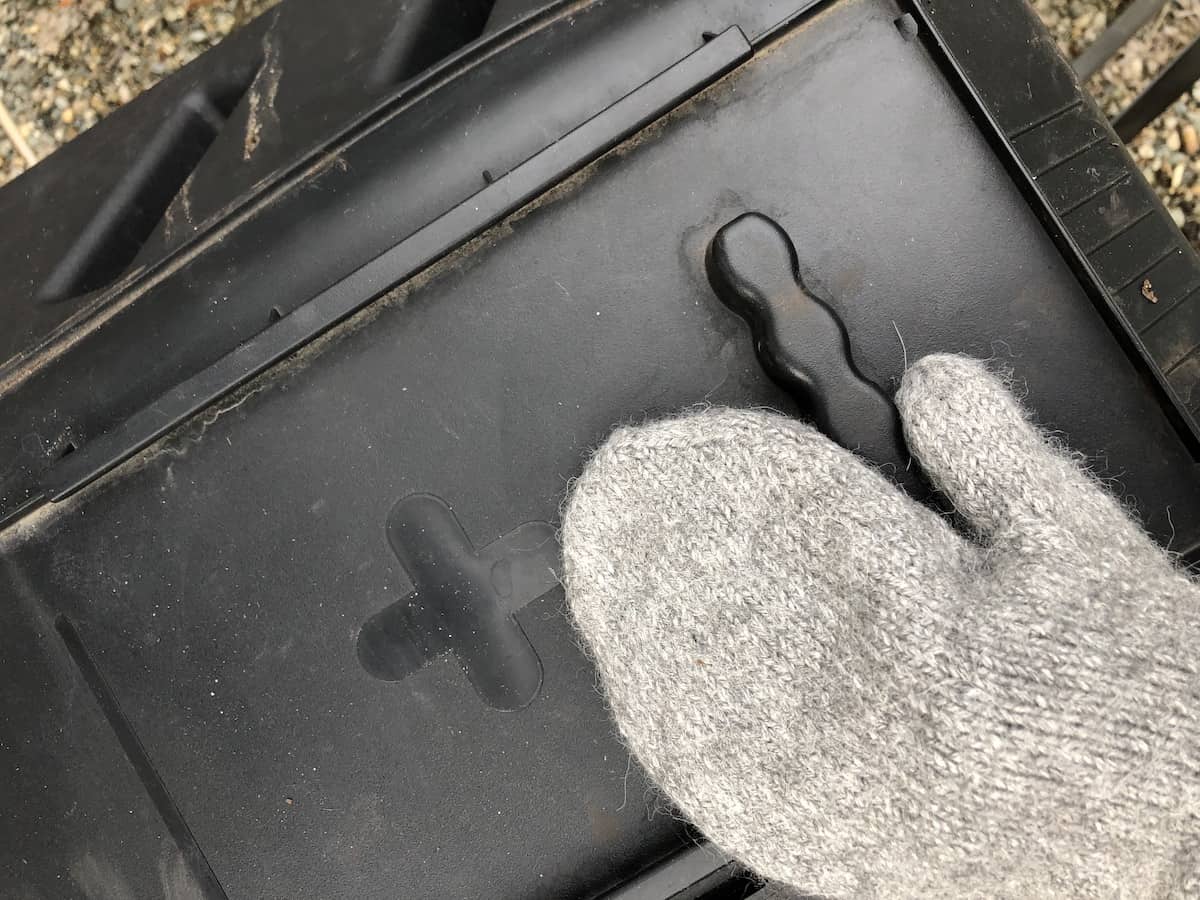
Tips to keep compost actively decomposing in the winter
Many composting basics apply to winter composting. Sun exposure can speed decomposition, whereas exposure to wind can cool the pile and slow decomposition. Food scraps that have been chopped into small pieces will decompose more quickly than whole vegetables.
Save the food scraps in a small compost bucket under the sink or freeze them to minimize kitchen odors. You can also fill up buckets outside over winter and add them to the compost later on. Stockpiling food scraps will reduce the number of trips to an outdoor compost pile.
“To reduce your cold winter trips to you bin, start a pre-compost bucket. You can use an empty bucket or trashcan in which you place your kitchen scraps. However, be sure to layer them with adequate browns to prevent smells. Add these materials to your outdoor bin whenever convenient or before your pre-compost bin gets too heavy.”
Winter Composting, Cornell University Cooperative Extension
Different microbes are active at different temperatures, and not all microbes decompose organics in the same manner. The lower temperatures in winter composting may not make for a hot enough compost pile to break down some invasive plants and seeds. Always consider what is going into the compost pile.
“The active bacterial colonies change with the temperatures of the compost. Hot piles promote thermophilic organisms (those that like heat). Ambient piles are mesophilic, and the most common; and psychrophilic are organisms that are active in the cold.”
Winter Compost Piles Are Still Working, Michigan State University Extension, by Beth Clawson
The size of the winter compost pile should be at least one cubic yard. Bigger can be better but make sure you don’t make it too large, or the centre of the pile may get quite dense. Then the center won’t get the air it needs. A larger pile will work best if the compost is made up of a lot of loose material.
“A pile of about one cubic yard is big enough for year-round composting, even in cold-winter areas.”
Backyard Composting, Washington State University Extension, by Craig Cogger, Dan M. Sullivan, and Andy Bary.
“The size of the compost pile is a factor for success, especially in the winter. A pile needs to have at least 1 cubic yard of material. Larger piles help insulate themselves, as the inside of the pile will be creating heat.”
Keep the Compost Cooking this Winter, Oregon State University Extension, by Melissa Fery
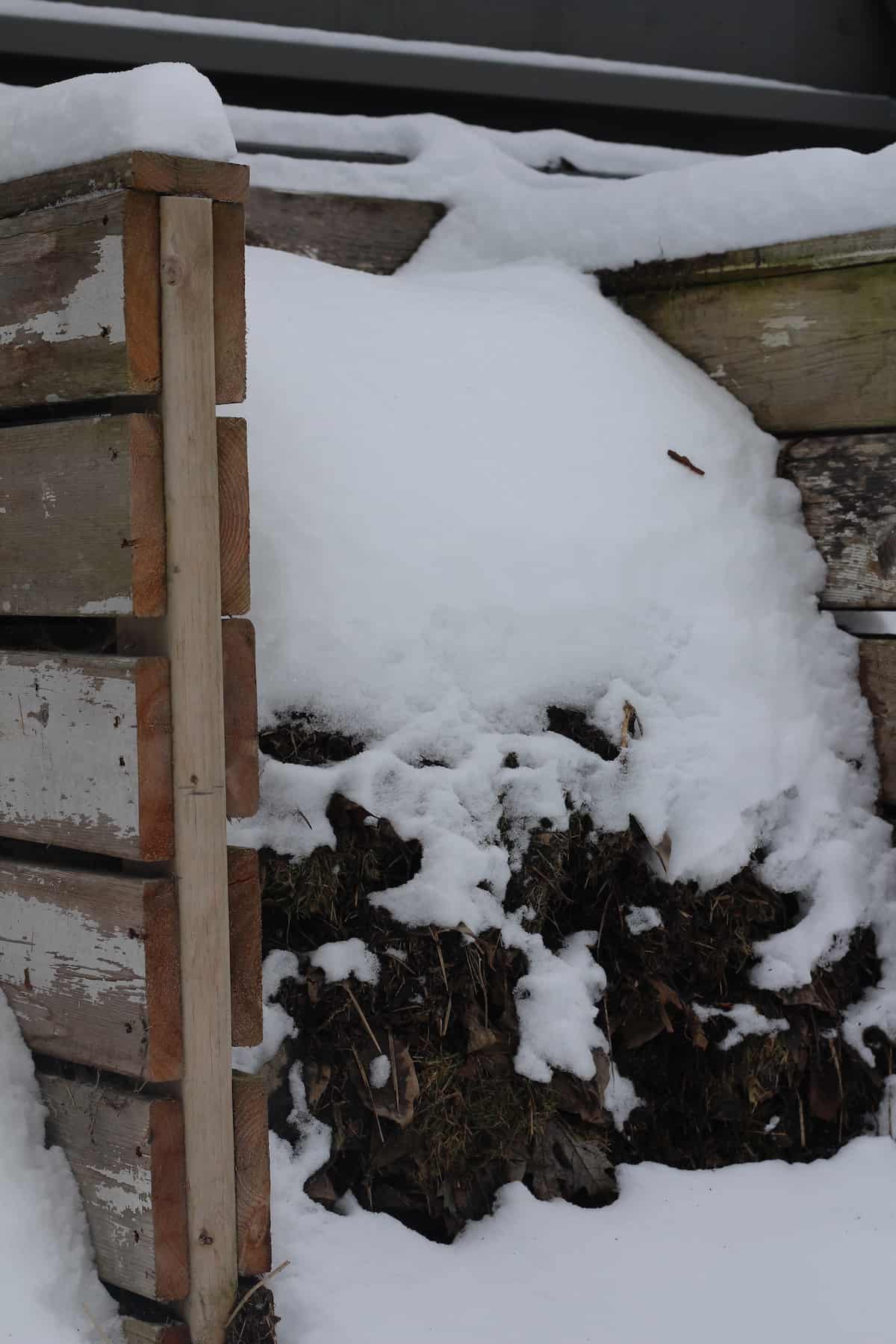
Autumn Compost Prep: Shred and Store Autumn Leaves
The first autumn task to prep for winter composting is to shred and store autumn leaves for use in the compost over the winter. You’ll need a stockpile of dry shredded leaves to add to the compost throughout the winter.
Most of the household compostable material produced during the wintertime is of the nitrogen-rich “green” type. We tend to produce food waste all year! This nitrogen-rich material should be balanced with carbon-rich “brown” material as the compost grows. Carbon-rich material is produced mainly in the fall (think dry autumn leaves and yard clippings).
So, collect and save your “brown ingredients” in the fall in addition to the compost during the winter. Consider making a pile of shredded leaves or storing them near the compost in five-gallon buckets. The shredded leaves will compose themselves into “leaf mold” compost over a year or two. But more importantly, the decomposing leaves can be added to the active compost pile to balance out food waste “greens” on an ongoing basis throughout the winter and spring.
Autumn Compost Prep: Create Empty Space
Another important step in winter composting is to create space for the organic waste produced during the winter. In the fall, empty the bin or area of finished compost before the snow falls. To provide adequate air, half-done compost should be turned and bulked up with low-density materials in the fall.
Fall is a great time to use finished compost as an organic soil amendment! Rake an inch-thick layer of compost over the lawn to top-dress it with nutrients. Vegetable gardens, flower beds, and trees and shrubs also benefit from an autumn surface application of homemade compost.
Now that the finished compost has been used in the yard, there should be lots of space for the food scraps created during the winter (and the shredded leaves added to balance the carbon-nitrogen ratio). It’s much easier to deal with finished compost in the fall (before it freezes!).
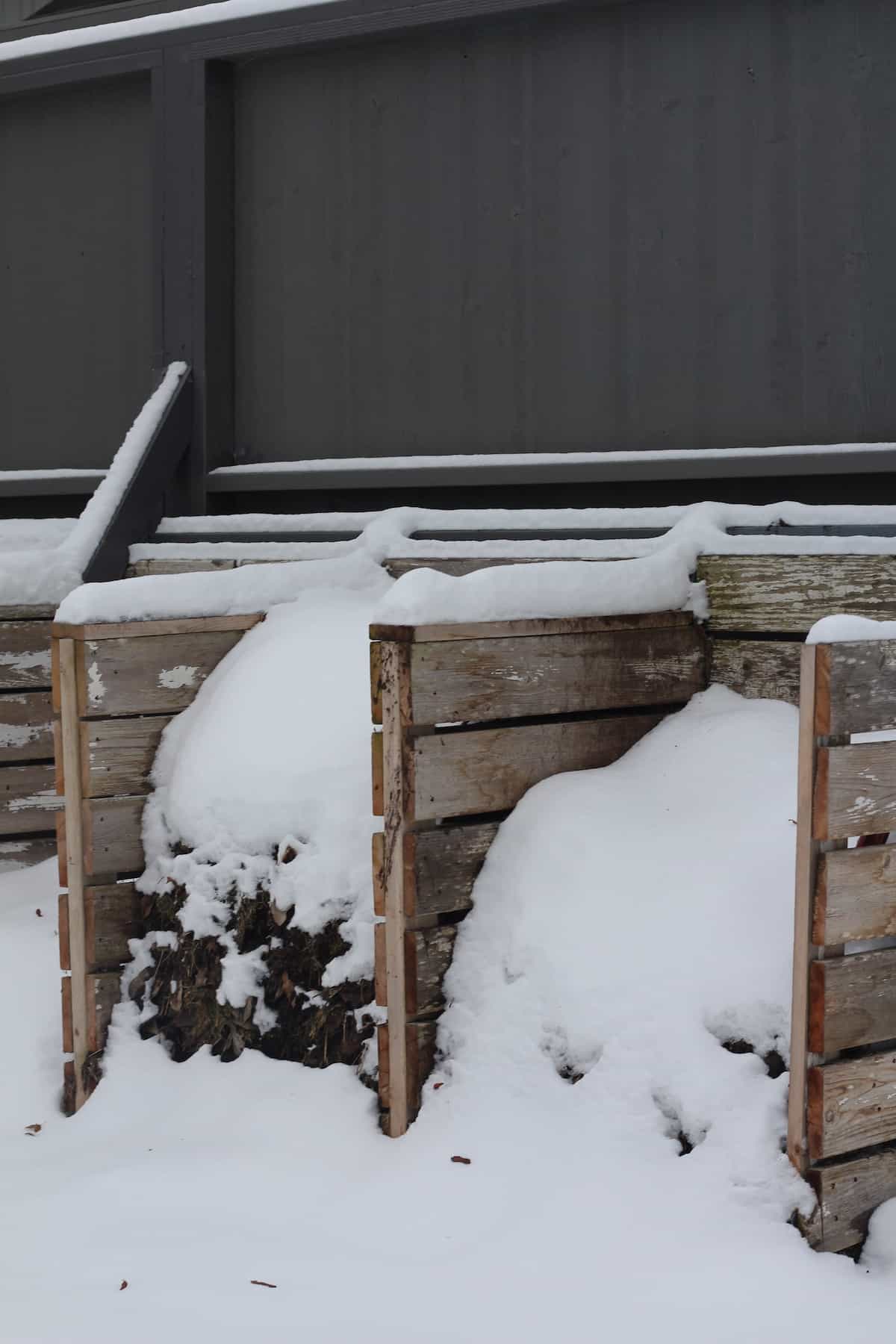
Should you turn the pile during the winter?
No, you shouldn’t turn the compost pile during the coldest months of winter. Turning the pile will result in a loss of heat from the center of the pile, so you should minimize the amount you turn the pile. You do still need to aerate the pile, though, and some materials may be more tolerant of turning than others.
Continue to build the pile, layering greens and browns, but don’t turn the whole thing while the temperatures are low. Place a layer of shredded leaves about 2-3 inches thick on top of each batch of food scraps added. Keep layering but wait until spring to turn.
“Although we turn compost piles in the summer, it is best to avoid turning the pile in winter to help maintain that interior warmth. With a little moisture, the decomposition process can continue.”
Thoughts on Composting, University of Nevada Cooperative Extension
Does a compost pile need to be covered in the winter?
Providing some cover for your compost pile over the winter is not a bad idea, but you should make sure that it can still “breathe”. Think of it like a carport for your compost! Covering a compost pile is most common in areas with wet, damp winters. Dry snow is an effective insulator and, therefore, isn’t a problem in true cold-winter areas.
A roof, tarp, or something similar that stops the pile from becoming waterlogged may be necessary for climates that get heavy winter precipitation. Too much water in the pile can leach nutrients, cool the pile, and interfere with composting. A tarp can also trap heat, allowing the decomposition process to work. Even a cover layer of straw, leaves, or shredded newspaper for insulation can help with warmth (and provide a bit of a carbon source).
“Insulating your bin will protect it form the harsh winter winds and cold. While the outside of you bin may freeze, the inside can still “cook.” “
Winter Composting, Cornell University Cooperative Extension
The heat from the decomposing organics may also melt snow that falls on the pile. The extra moisture may be undesirable if the pile already has enough moisture.
Don’t cover the pile while it seems too moist or dry. If it’s sopping wet, let it dry out in the open air before covering it. Turn it over in the fall to move the drier bits toward the bottom of the pile. This will let the areas with too much moisture start to dry out.
If you are covering your pile with a tarp, then layer garden waste, such as leaves and grass, on the top layer of the pile. This material is less dense than kitchen waste and tends to have better airflow. You may also want to consider putting something like piping under the tarp to create an air gap that will let the pile breathe.
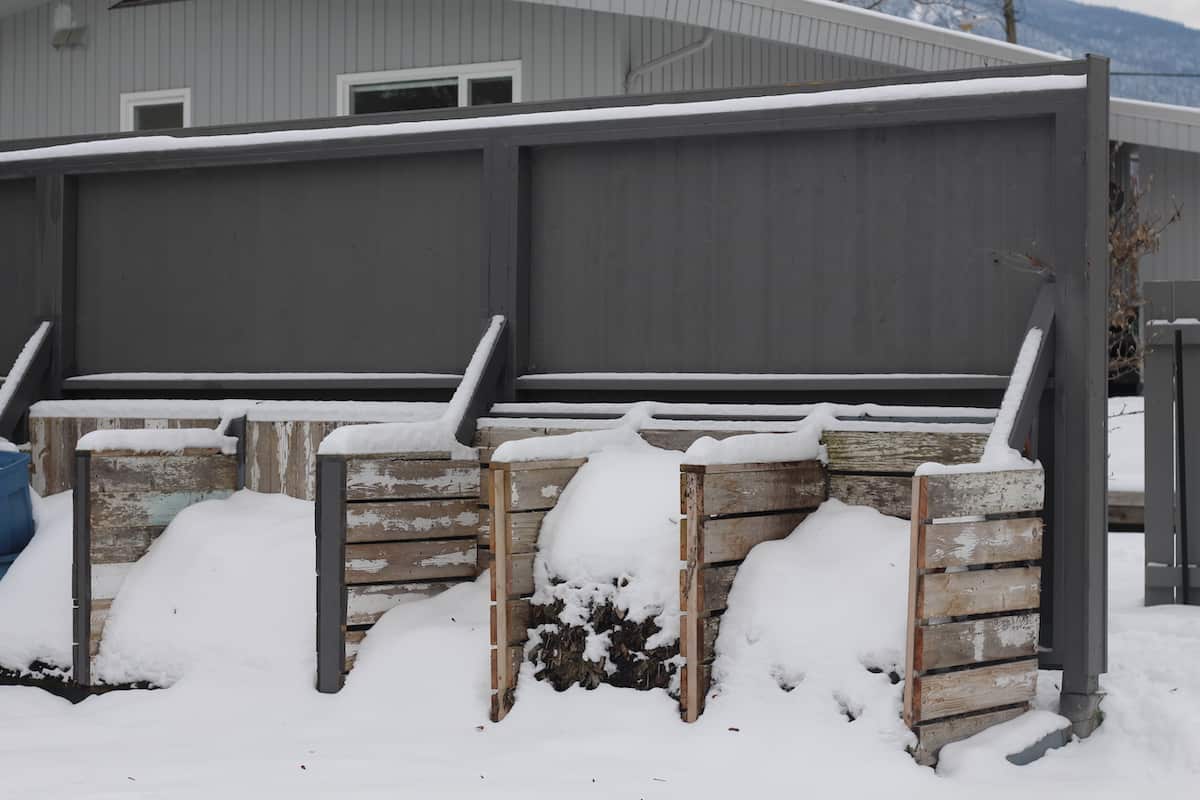
Wind barriers in winter composting
The cold winter wind can dry out your compost pile and draw heat away from it. Some compost methods include protecting an outdoor compost pile with a wind barrier. A windbreak can also make a good sight barrier if you don’t want your compost heap to be a feature in your winter landscape.
The set-up of the windbreak depends on each compost heap’s unique situation. Part of the pile may already be walled off. Whatever your windbreak layout is, make sure that you leave enough room to access the compost pile when you need to top it up or remove the finished compost.
For aesthetics, consider adding an ornamental wall in front of the pile. You could build a frame to grow some ivy, passionfruit, climbing roses, or a different vining plant. Or, add some shrubs or short bushy trees to further protect the pile from the wind.
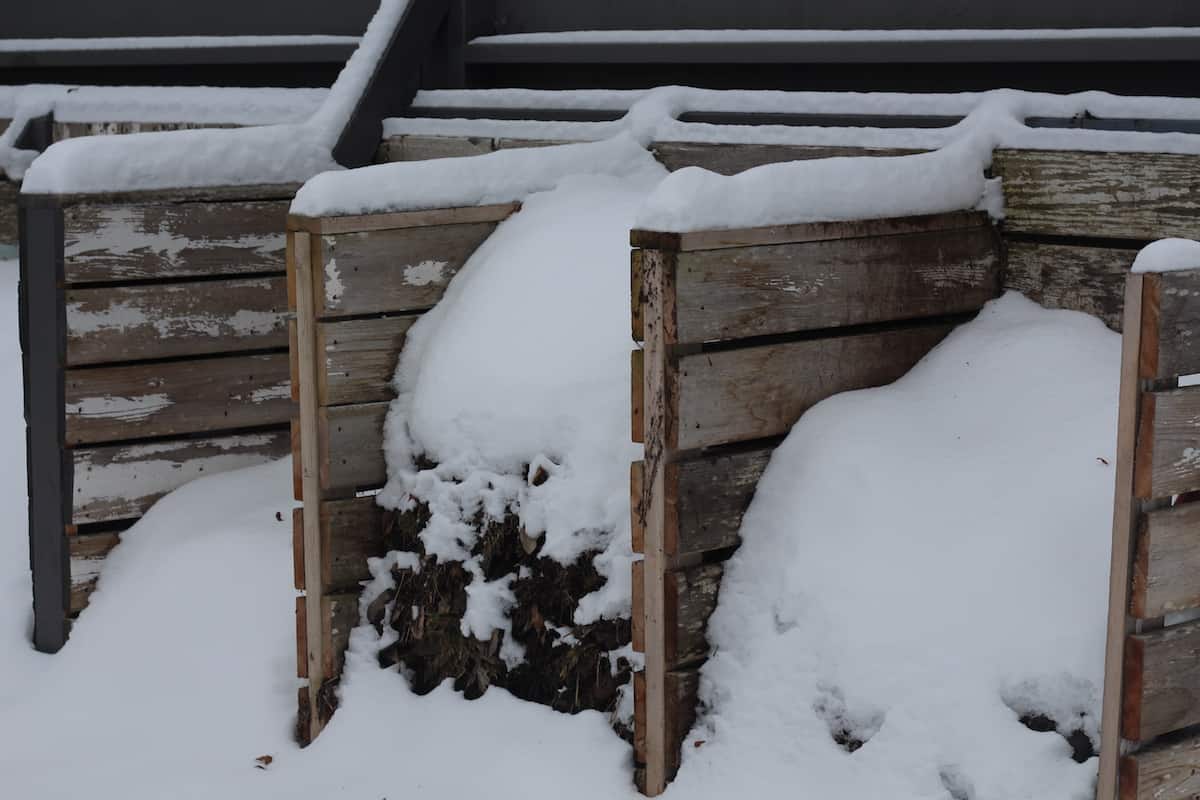
More tips for winter composting
While your composting may be slowed down over winter time, it is still well worth doing. As long as you take some care with how you approach it and protect your compost pile from the harshest winter conditions, you should be able to cook up a healthy mix of composted soil ready for your spring gardening.
The microbes in the compost will be less active in cold weather but will still do their job even if they do it at a slower pace. So don’t waste those winter months! Put them to use, turning your leftover kitchen scraps into fertile homemade compost.


